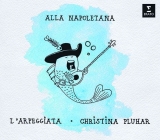Neapel hat viel Musiker inspiriert, und Christina Pluhar hat mit L‘Arpeggiata ein 104 Minuten langes neapolitanisches Album mit 20 Titeln zusammengestellt, wovon die meisten von Pluhar selber bearbeitet wurden. Es sind Kanzonen, Arien und auch eine Kantate, La Veglia von Cristoforo Caresana. Dafür hat Cristina Pluhar nicht weniger als acht Solisten eingeladen.
Es gibt in diesem Programm ganz deliziöse Momente, etwa wenn der Countertenor Valer Sabadus mit unvergleichlicher Poesie Pietro Andrea Zianis Dormite o pupille singt oder wenn der Altus Vincenzo Capezzuto das so bekannte Lied Dicitencello vuje! von Rodolfo Falvo interpretiert, das durch Gigli, Carreras, Pavarotti, Domingo und viele andere bekannt gemacht wurde und hier in völlig neuen Farben erklingt. Auch Sigismondo d’Indias Sfere fermate, gesungen vom Sopranisten Bruno de Sá ist ein besonderer Genuss. Und unbedingt erwähnt werden muss die wunderbare Pastorale aus Cristoforo Caresanas Serenata, die bis auf Sá alle Solisten vereint.
Naples has inspired many musicians, and Christina Pluhar and L’Arpeggiata have put together a 104-minute Neapolitan album of 20 tracks, most of which have been arranged by Pluhar herself. There are canzonas, arias and also a cantata, La Veglia by Cristoforo Caresana. For this program Cristina Pluhar invited no less than eight soloists.
There are quite delicate moments in this program, for example when the countertenor Valer Sabadus sings Pietro Andrea Ziani’s Dormite o pupille with incomparable poetry, or when the alto Vincenzo Capezzuto is heard in the so well-known song Dicitencello vuje! by Rodolfo Falvo, which was made famous by Gigli, Carreras, Pavarotti, Domingo and many others and is becoming here completely new colors. Sigismondo d’India’s Sfere fermate, sung by soprano Bruno de Sá, is also a special treat. And a must mention is the wonderful Pastorale from Cristoforo Caresana’s Serenata, which unites all soloists except Sá.






















